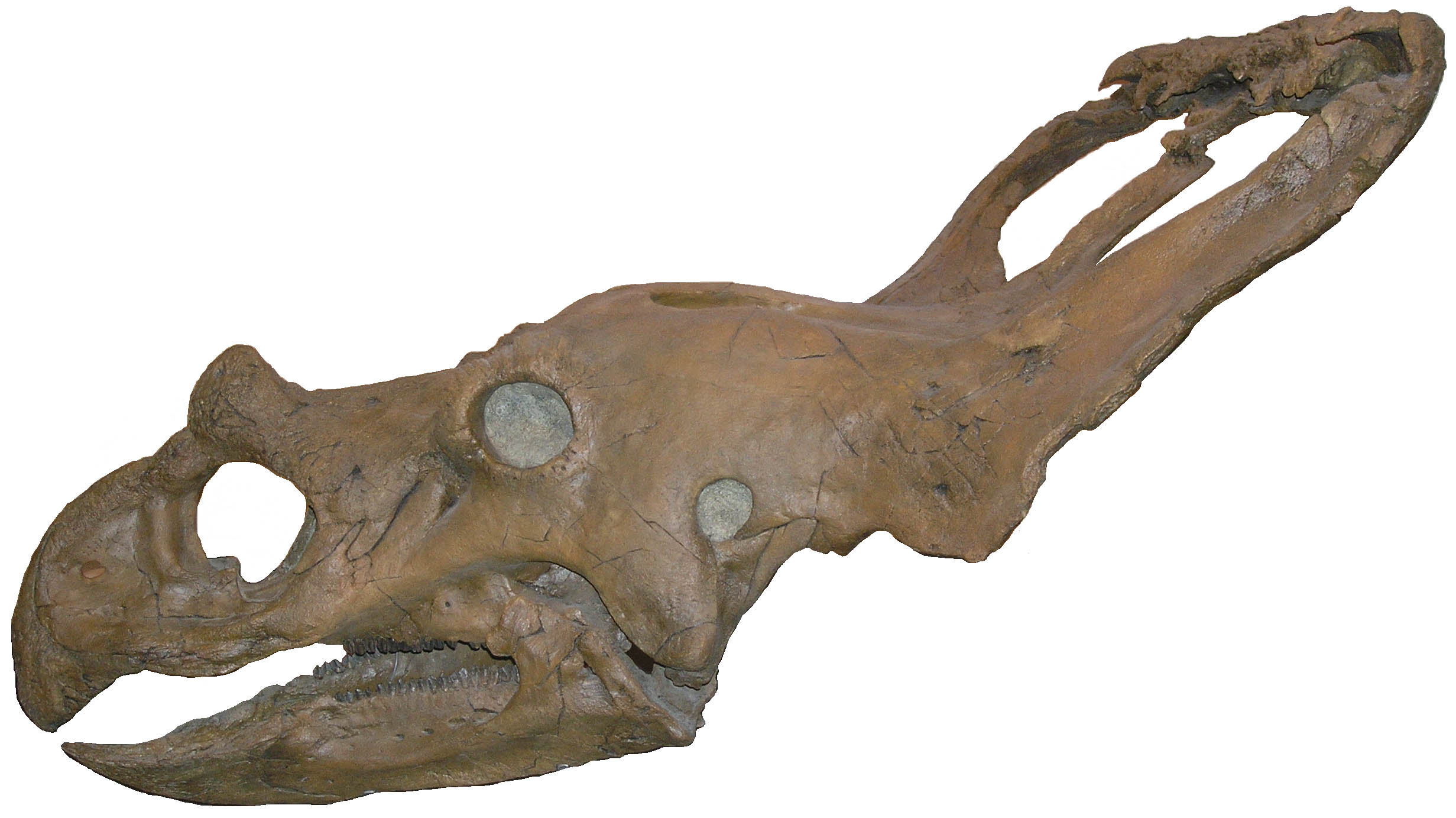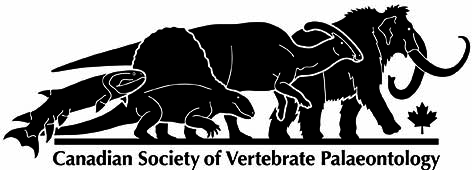Xiphactinus audax Leidy 1870 from the Puskwaskau Formation (Santonian to Campanian) of northwestern Alberta, Canada and the distribution of Xiphactinus in North America
DOI:
https://doi.org/10.18435/B5H596Keywords:
Ichthyodectiformes, Late Cretaceous, marine, Teleostei, Western Interior BasinAbstract
Xiphactinus is one of the largest teleost fish known from the Late Cretaceous of North America, and has been found across much of the Western Interior Basin. Despite extensive Late Cretaceous marine deposits occurring in Alberta, there has previously been only two possible records of Xiphactinus from the province, neither of which has been diagnosable to the species level. We describe here a portion of the lower jaws, including teeth, of Xiphactinus audax from northeast of Grande Prairie, Alberta. The fossil has large, thecodont teeth that are circular in cross section and lack any carinae, and are highly variable in their overall size. This fossil is the first diagnostic material of X. audax from Alberta, and extends the range of the species by over a thousand kilometres. During the Late Cretaceous, the area the fossil was found in was near the Arctic Circle, and represents an important datapoint within the poorly known, northern portion of the Western Interior Basin.
Downloads
References
Applegate, S.P. 1970. The vertebrate fauna of the Selma
Formation of Alabama. Part VIII. The fishes. Fieldiana: Geology
Memoirs 3:365–433.
Bardack, D. 1965. Anatomy and evolution of chirocentrid fishes.
University of Kansas Paleontological Contributions 10:1–88.
Bardack, D., and G. Sprinkle. 1969. Morphology and relationships
of saurocephalid fishes. Fieldiana Geology 16:297–340.
Bell, P.R., F. Fanti, M.T. Mitchell, and P.J. Currie. 2014. Marine
reptiles (Plesiosauria and Mosasauridae) from the Puskwaskau
Formation (Santonian–Campanian), West-Central Alberta.
Journal of Paleontology 88:187–194.
Everhart, M.J., P.A. Everhart, E. Manning, and D. Hattin. 2003.
A middle Turonian marine fish fauna from the Blue Hill Shale
Member, Carlile Shale, of north central Kansas. Journal of
Vertebrate Paleontology 23(supplement 3):49A.
Everhart, M.J., P.A. Everhart, and K. Ewell. 2004. A marine ichthyofauna from the upper Dakota Sandstone (Late Cretaceous).
Abstracts of oral presentations and posters, Joint Annual Meeting
of the Kansas and Missouri Academies of Science, p. 48.
Gallagher, W.B. 2002. Faunal changes across the Cretaceous-
Tertiary (K-T) boundary in the Atlantic coastal plain of New
Jersey: restructuring the marine community after the K-T
mass-extinction event. Catastrophic events and mass extinctions:
impacts and beyond. Geological Society of America
Special Paper 356:291–301.
Gallagher, W.B., D.C. Parris, and E.E. Spamer. 1986.
Paleontology, biostratigraphy, and depositional environments
of the Cretaceous-Tertiary transition in the New Jersey coastal
plain. The Mosasaur 3:1–35.
Gardiner, B. 1966. Catalogue of Canadian fossil fishes. Royal
Ontario Museum Life Science Contribution 68:1-154.
Grandstaff, B.S., D.C. Parris, R.K. Denton Jr., and W.B.
Gallagher. 1992. Alphadon (Marsupialia) and Multituberculata
(Allotheria) in the Cretaceous of Eastern North America.
Journal of Vertebrate Paleontology 12:217–222.
Hills, L. V., E.L. Nicholls, L.K. Núñez-Betelu, and D.J.
McIntyre. 1999. Hesperornis (Aves) from Ellesmere Island
and palynological correlation of known Canadian localities.
Canadian Journal of Earth Sciences 36:1583–1588.
Hu, Y.G., and Plint, A.G. 2009. An allostratigraphic correlation
of a mudstone-dominated, syn-tectonic wedge: The Puskwaskau
Formation (Santonian-Campanian) in outcrop and subsurface,
Western Canada Foreland Basin. Bulletin of Canadian
Petroleum Geology, 57:1–33.
Irving, E., P.J. Wynne, and B.R. Globerman. 1993. Cretaceous
paleolatitudes and overprints of North American craton.
Geological Association of Canada, Special Paper 39:91–96.
Irwin, K.J., and C. Fielitz. 2013. Ichthyodectiform fishes from
the Late Cretaceous (Campanian) of Arkansas, USA; pp. 247–
in G. Arratia, H.-P. Schultze, and M.V.H. Wilson (eds).
Mesozoic Fishes 5 – Global Diversity and Evolution. Verlag Dr.
Friedrich Pfeil, München, Germany.
Kauffman, E.G. 1977. Geological and biological overview: Western
Interior Cretaceous Basin. The Mountain Geologist 14:75–99.
Kauffman, E.G. 1984. Paleobiogeography and evolutionary
response dynamic in the Cretaceous Western Interior Seaway
of North America. Geological Association of Canada, Special
Paper 27:273–306
Lauginiger, E.M. 1984. An upper Campanian vertebrate fauna
from the Chesapeake and Delaware Canal, Delaware. The
Mosasaur 2:141–149
Lauginiger, E.M. 1986. An Upper Cretaceous vertebrate assemblage
from Big Brook, New Jersey. The Mosasaur 3:53–61.
Leidy, J. 1856. Notices of remains of extinct vertebrated animals
of New Jersey, collected by Prof. Cook of the State Geological
Survey under the direction of Dr. W. Kitchell. Proceedings of
the Academy of Natural Sciences of Philadelphia 8:220–221.
Leidy, J. 1870. Remarks on ichthyodorulites and on certain fossil
Mammalia. Proceedings of the Academy of Natural Sciences of
Philadelphia 22:12–13.
Liggett, G.A., K. Shimada, S.C. Bennett, and B.A. Schumacher.
Cenomanian (Late Cretaceous) reptiles from northwestern
Russell County, Kansas. Paleobios, 25:9–17.
Manning, E.M., and D.T. Dockery III. 1992. A guide to the
Frankstown vertebrate fossil locality (Upper Cretaceous),
Prentiss County, Mississippi. Mississippi Department of
Environmental Quality, Office of Geology Circular 4:1–43.
Martin, L.D., and J.D. Stewart. 1977. The oldest (Turonian)
mosasaurs from Kansas. Journal of Paleontology 51:973–975.
Martin, L.D., and J.D. Stewart. 1982. An ichthyornithiform bird
from the Campanian of Canada. Canadian Journal of Earth
Sciences 19:324–327.
Nelson, G.J. 1973. Notes on the structure and relationships of
certain Cretaceous and Eocene fishes. American Museum of
Natural History Novitates 2524:1–31.
Nicholls, E.L. 1988. Marine vertebrates of the Pembina
Member of the Pierre Shale (Campanian, Upper Cretaceous)
of Manitoba and their significance to the biogeography of the
Western Interior Seaway. Ph.D. Thesis, University of Calgary,
Calgary, Alberta, 317 pp.
Patterson, C., and D.E. Rosen. 1977. Review of ichthyodectiform
and other Mesozoic teleost fishes and the theory and
practice of classifying fossils. Bulletin of the American Museum
of Natural History 158:81–172.
Phillips, G., and E. Loftis. 1999. A significant late Santonian (Upper
Cretaceous) vertebrate fossil site in Lowndes Co., Mississippi.
Journal of the Mississippi Academy of Sciences 44:42.
Robb, A.J., III. 1989. The Upper Cretaceous (Campanian, Black
Creek Formation) fossil fish fauna of Phoebus Landing, Bladen
County, North Carolina. The Mosasaur 4:75–92.
Russell, D.A. 1967. Cretaceous vertebrates from the Anderson
River, N.W.T. Canadian Journal of Earth Sciences 4:21–38.
Russell, D.A. 1988. A checklist of North American marine
Cretaceous vertebrates including fresh water fishes. Tyrrell
Museum of Palaeontology Occasional Papers 4:1–58.
Schwimmer, D.R., J.D. Stewart, and G.D. Williams. 1997.
Xiphactinus vetus and the distribution of Xiphactinus species
in the eastern United States. Journal of Vertebrate
Paleontology 17:610–615.
Shimada, K., and M.J. Everhart. 2004. Shark-bitten Xiphactinus
audax (Teleostei: Ichthyodectiformes) from the Niobrara Chalk
(Upper Cretaceous) of Kansas. The Mosasaur 7:35–39.
Shimada, K., B.A. Schumacher, J.A. Parkin, and J.M. Palermo.
Fossil marine vertebrates from the lowermost Greenhorn
Limestone (Upper Cretaceous: middle Cenomanian) in southeastern
Colorado. Journal of Paleontology 80:1–45.
Vertebrate Anatomy Morphology Palaeontology 1(1):89-100
Smith, A.G., D.G. Smith, and B.M. Funnell. 1994. Atlas of
Cenozoic and Mesozoic coastlines. Cambridge University Press,
Cambridge, 99 pp.
Stephenson, L.W. 1912. The Cretaceous formations of the coastal
plains of North Carolina. North Carolina Geological Survey
Report 3:73–171.
Stott, D.F. 1963. The Cretaceous Alberta Group and equivalent
rocks, Rocky Mountain Foothills, Alberta. Geological Survey of
Canada, Memoir 317, 306 pp.
Stott, D.F. 1967. The Cretaceous Smoky Group, Rocky
Mountain Foothills, Alberta and British Columbia. Geological
Survey of Canada, Bulletin 132, 133 pp.
Vavrek, M.J., L.V. Hills, and P.J. Currie. 2014a. A hadrosaurid
(Dinosauria: Ornithischia) from the Late Cretaceous
(Campanian) Kanguk Formation of Axel Heiberg Island,
Nunavut, Canada, and its ecological and geographical implications.
ARCTIC 67:1–9.
Vavrek, M.J., A.M. Murray, and P.R. Bell. 2014b. An early Late
Cretaceous (Cenomanian) sturgeon (Acipenseriformes) from
the Dunvegan Formation, northwestern Alberta, Canada.
Canadian Journal of Earth Sciences 51:677–681.
Wiley, E.O., and J.D. Stewart. 1981. Urenchelys abditus, new
species, the first undoubted eel (Teleostei: Anguilliformes)
from the Cretaceous of North America. Journal of Vertebrate
Paleontology 1:43–47.
Williston, S.W. 1894. On various vertebrate remains from the
lowermost Cretaceous of Kansas. Kansas University Quarterly
(1):1-4, pl. I.
Wilson, M.V.H., and Y. Chalifa. 1989. Fossil marine actinopterygian
fishes from the Kaskapau Formation (Upper Cretaceous:
Turonian) near Watino, Alberta. Canadian Journal of Earth
Sciences 26:2604–2620.
Witzke, B.J. 1981. Cretaceous vertebrate fossils of Iowa and
nearby areas of Nebraska, South Dakota and Minnesota; pp.
–122 in R.L. Brenner, R.F. Bretz, B.J. Bunker, D.L. Iles,
G.A. Ludvigson, R.M. McKay, D.L. Whitley, and B.J. Witzke
(eds). Cretaceous Stratigraphy and Sedimentation in Northwest
Iowa, Northeast Nebraska, and Southeast South Dakota. Iowa
Geological Survey Guidebook Series, Number 4.
Downloads
Published
How to Cite
Issue
Section
License
Copyright (c) 2016 Matthew J. Vavrek, Alison M. Murray, Phil R. Bell

This work is licensed under a Creative Commons Attribution 4.0 International License.
Submission of an article to Vertebrate Anatomy Morphology Palaeontology will be taken to mean that the article is an original work and not previously published or under consideration for publication elsewhere.
If the article is accepted for publication, it will be published on-line under Creative Commons Attribution 4.0 International (CC By 4.0) meaning:
Attribution — You must give appropriate credit, provide a link to the license, and indicate if changes were made. You may do so in any reasonable manner, but not in any way that suggests the licensor endorses you or your use.
No additional restrictions — You may not apply legal terms or technological measures that legally restrict others from doing anything the license permits.







